|
|
||
|
|
Select Aquatics of Erie, CO |
|
|
|
Breeding the Puntius padamya "Odessa" Page 2 - Breeding Overview
|
|
|
|
|
|
|
Page 1: Odessa Barbs, Origins of the Odessa Barb * Page 2: Overview of Breeding the Puntius padamya Page 3: Step by Step Specifics of How We Breed Them Here Page 4: An Easier (But less Yield) Way to Breed Them
|
|
|
|
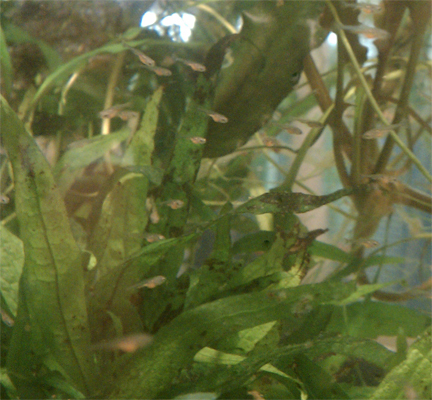 |
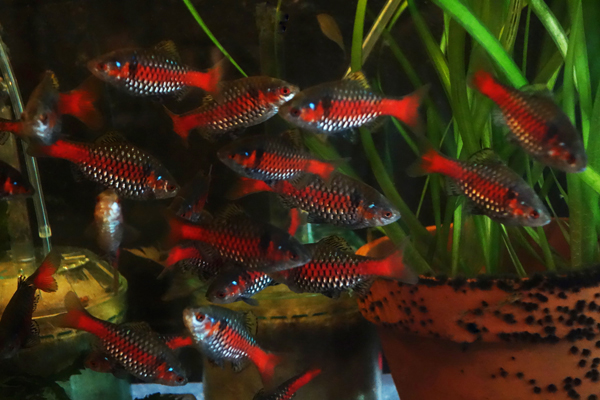 |
|
|
|
These fry are 9 days old, and some of the males from this batch grew into the males seen at right. |
|
|
|
|
|
|
These fish are egg
scatterers, and release mildly adhesive eggs. The issues are
saving the eggs so they are not eaten, and feeding the young appropriately so that you lose as few as possible during their first 2 weeks. At the same time, oxygenation and water quality is everything for the new fry- and massive water changes (50% at least 3x daily the first week, 30-50% 3x daily next 2-3 weeks) must be kept up of prepared, aged aquarium water. I use relatively clean aquarium water taken from another established tank. There are a number of little things you will learn that will increase your yield, and I can share what I have discovered. Over the past 5 years I have spawned and raised the fry about 30 times, and I am still tinkering with the process. A long time in the making, this essay will reveal everything that we do here to get batches routinely of 500 - 1500 fry, generally from about 3 trios with each spawning. I refer in my instructions to using 3-4 males and 7-9 females in the breeding sessions I do here, but everything described here can be done with a pair, or a trio, or whatever. I would not add more than the number of fish I use, however. Any more than what I use here in that size tank, and you may end up with far more fish eating eggs than producing them! Breeding these is one of the most rewarding things I do, but to bring a batch to the point of being divided up into their own tanks will take 30 days, and you must be home to feed 3x per day, doing a 50% water change following each feeding for at least the first 3 weeks. Feedings must be done at 8-9am, 2-3 pm, and again at 8-9pm. Missing an evening feeding, for example, means the fish will go from 2 pm until 8am the next morning. Odessa fry - like all very small fry, are no more than eyes and a tail that can be barely seen. They generally cannot go more than the 12 hours that occurs overnight. Missing a single feeding can mean losing a substantial portion - over 50%, of the new fry. If you would like to breed them more than once, I strongly recommend keeping a journal of what you do each day (How long do you keep the adults together? When do you introduce the vinegar eels and how much do you feed? When do you start them on the baby brine shrimp?) I keep the adults together 2-5 days depending on when the females slim down, and what has proven to produce the most fry in my setup, etc. Vinegar eels will cloud the water, so you don't want to add them too early and fungus the eggs, but you want them there- alive- soon after the fry hatch. They start getting BBS about day 5-6, but keep both going during this period as their rate of growth - depending on when they hatch- will vary considerably. Microworms or paramecium should also work as a first food. the infusoria is there for those first 1-3 days before they start feeding on vinegar eels. It works perfectly for the new fish hatching out, and most engorge on the vinegar eels as soon as they can. I use vinegar eels here because they require no maintenance, and are always ready to go. I keep 30 2 liter soda bottles of cultures going. When I am feeding the Odessas regularly, I will go through 6 bottles a day (3 feedings, eels from 2 bottles each feeding). I have found than when starting at bottle 1, and going through to bottle 30, the bottles have about a week to replenish themselves, which works out just right. I routinely ship vinegar eel cultures to customers if you do not have any available in your area, simply email me at selectaquatics@gmail.com and we can arrange to get some out to you. |
|
|
|
|
|
|
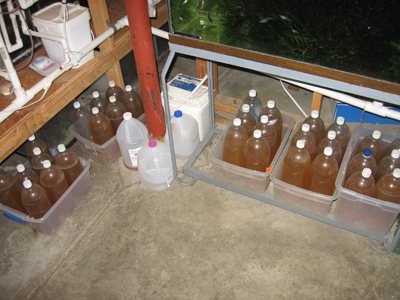
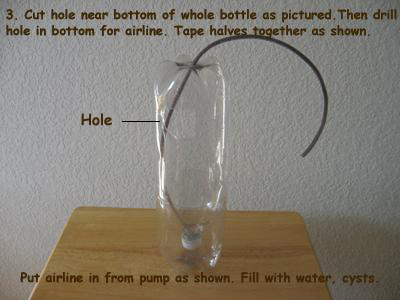
|
|
|
|
Vinegar eels ready for next spawning
To build this simple, effective Brine Shrimp Hatcher, Click HERE You will need both Vinegar eels (or microworms, paramecium, etc.) and newly hatched Baby Brine Shrimp (BBS) to raise the Odessa barb fry. |
|
|
|
|
|
|
Though most sources claim
this is a cold water species, I have found that they are most
comfortable (their color and activity is best) in the upper 70ís. I tried to breed them at 72 degrees without much success, and eventually found that they breed eagerly at 77-78 degrees. I use the white plastic "egg-crate" style light covering material to make a horizontal divider, cut to the breeding tank size. To that are attached single layer thick, green plastic cross-stitch backing material- attached with small plastic electrical ties. Adults are introduced above the divider with lots of Java fern, and eggs would fall down through the mesh, or stick to the plant leaves. The water level of the tank where the breeding takes place must stay low- 6-7 inches, or the young will develop air bladder problems, becoming belly-sliders. When that happens they can be put into a breeder up near the top of another aquarium, and raised there. About 75% will overcome it as they age over 1-2 months. |
|
|
|
|
|
|
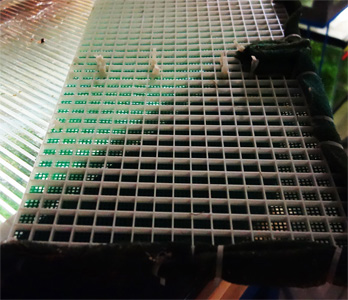
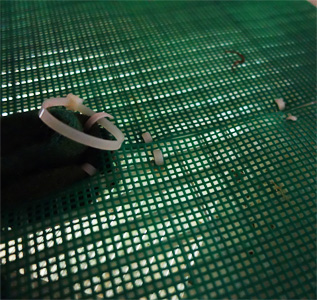
|
|
|
|
|
An
example of the Odessa divider that fits a 29 tall tank. Cross
stitch backing is attached with electrical ties to honeycomb
light |
|
|
|
|
|
|
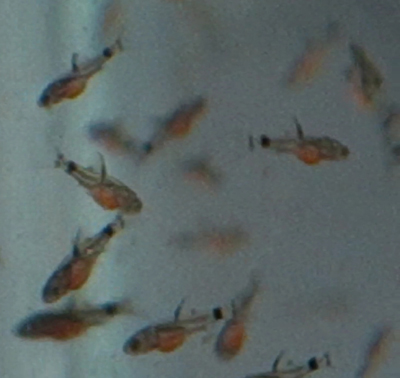
|
|
|
|
These young Odessa barbs are 30 days old. |
|
|
|
|
|
|
When beginning
with young fish, females and males are separated as males sex
out, which takes 6-8 months. Both males and females are conditioned on frequent feedings of dry and live foods. The largest, heaviest egg-laden females with the best color are pulled, as well as the males with traits I am breeding for. A clean tank is prepared without little shrimp or snails present (as much as possible, but eggs inevitably come in with the plants taken from another tank). Clean aquarium water is added with a generous amount of plants, and a couple airstones. Plants are divided up about 50/50 above and below the divider. Any healthy
female that is old enough will fill with eggs, and stay that way
until she breeds. Older texts used to present "conditioning the
|
|
|
|
|